#the covers are made from this pink cloth that has white flowers w/ blue core on it! that cloth has been in the bottom of my closet for
Text
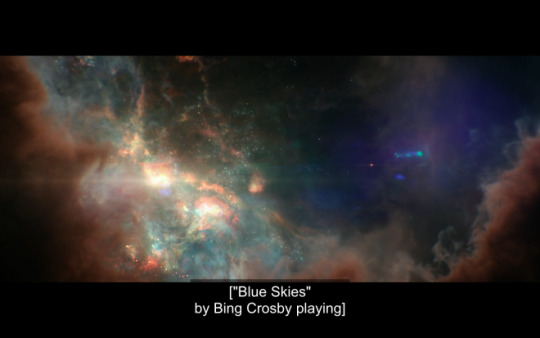
Star Trek Picard S1E1- The Blue and Red Skies of Picard’s Dream
From the first moments of Jean Luc Picard’s dream in the pilot, Star Trek: Picard has been using a color scheme as part of its symbolism. Picard’s dream about Data, 5 queens, drinking tea and the attack on Mars is one prescient symbol after another. In this post, let’s examine how the creators of the show are using color.
The most symbolically important colors are red, green and blue. Gold/yellow, orange and white also play a lesser role. When the colors mix, the message is more complex. Fire/flames/explosions and the use of lighting are closely tied to the use of color. Often color will be expressed through lighting, sometimes as a hazy wash of colored light. Gold is particularly used this way on Chateau Picard and in Picard’s holographic study on La Sirena. Green is almost exclusively used in Romulan lighting, except for the greenery on Nepenthe, a few items of green clothing and Soji’s eyes. Red can be in the form of light, but if it is, most often it comes as a form of fire, tied to red’s core meaning of “real”.
Red Is Real: Truth, Passion, Humanity, Valor
Deanna with her homegrown tomatoes on Nepenthe.
Rios’ Red Is Real cigar box with all of his important memories inside.
The color red has the most distinct imagery and symbolic meaning, having been spelled out clearly twice by trusted sources. In episode 7, Nepenthe, Deanna and Soji discussed the “realness” of the bright red tomatoes grown in Deanna’s garden. Deanna told Soji that the tomatoes are real, but real isn’t necessarily better than synthetic, since a positronic matrix could have saved her son’s life. In episode 8, Broken Pieces, Rios’ cigar box of keepsakes is red, with the word “real” printed in large letters on the outside. What’s inside the box is what’s real, as opposed to the manipulations of the truth happening outside, and the box’s red exterior signals that we can trust those keepsakes and the memories attached to them.
So what does “real” mean, in this context? Picard is also real. He wears a deep red/burgundy sweater early in episode 1. Chateau Picard is laced with flowers in the red family. As noted above, Chris is also real, with his red cigar box. He’s bleeding red blood when we meet him, illustrating the reason why red is the color which symbolizes humanity, authenticity, truth, passion, human emotion and being a flesh and blood living being.
There is also an element of straightforward morality, as Picard sees it, associated with red. Picard himself is the symbol of Gene Roddenberry’s original vision for the Federation and Starfleet as a society of beings who have evolved into a level of maturity and self-control that lets them rein in their baser instincts the vast majority of the time. It’s important to remember that those baser instincts still exist. What has evolved is the determination to suppress them and continue the ideas of the Enlightenment, such as individualism characterized by an emphasis on science, rationalism, personal and religious freedoms, self-governance and equality.
The values associated with red mean seeing the synths as equal citizens deserving of their rights. The Romulans believe this will lead to disaster, so red spans the continuum from the deep red warmth of family and acceptance, which we’ve seen Picard wear, to the fiery red harshness of exploding planets in the Admonition. Deanna wore a soft peachy pink when she was in her garden at her family home. Soji and Dahj’s orchids were both also in the softer end of the red spectrum. Laris wore a rusty red turtleneck, signifying her fiery personality.
Fire has been used in mild situations such as the candles on the Troi-Riker dinner table and the fire in Chateau Picard’s hearth, as well as cataclysmic visuals such as the attack on Mars and the mass destruction of the Admonition. There must be some important truth in each of these situations along with their human emotion.
Soji wore a bright red hazmat suit to work in the reclamation zone and when she spoke to Hugh about some of their more subversive ideas. Romulans are rarely associated with red and generally only briefly. Narek and Narissa had a heart made of light between them when she told him not to fall in love with Soji. The heart was as important as the color, showing the importance of love and family to all three people involved, and perhaps hinting at the direction of Narek’s true loyalty.
Click on any image to enlarge.
Green Is Complexity and Often Morally Gray or Worse
The Romulans love green. They keep the Artifact swathed in this color that represents moral complexity and mind games. It often signifies the presence of lies, oppression, deception, enslavement and cruelty. Occasionally it denotes a deception that is for the greater good or to save someone’s life.
The main uses of green have been in the control holograms and force fields on the Artifact and the plant life on Nepenthe and Earth. On the Borg cube, the Zhat Vash were deceiving Soji and the xBs into thinking they were helping the xBs when their real motive was to find and learn about Soji. They planned to destroy the cube and all of the xBs once their mission was complete. Narak and Narissa lied and played mind games with Soji while the entire Borg Reclamation Project was a ruse in pursuit of their larger goal.
Seven with Borg Life Signs
On Earth, Jean Luc fooled himself for years that he could be happy on the vineyard, growing grapes, if he just tried harder. Raffi used her snakeweed vine as her vape addiction, carefully tending the vine so it would continue producing for her. The snakeweed kept her numb to her own circumstances for years.
On Nepenthe, Will and Deanna’s home is surrounded by forest and green plants. At first I didn’t think this example fit with the green symbolism. But now I have a couple of ideas. The canon solution is that they pretend to be a happy, intact family in the woods, despite their deep sadness over the loss of their son, Thad. Kestra plays the outdoor games she used to play with her brother and pretends she isn’t lonely. This fits with the other uses of plants in Picard: people using greenery as a form of comfort to deny loss.
I wonder though, if the green might signify that in addition to the family’s natural sadness and stress from Thad’s illness, they are deceiving Picard and Soji. It’s possible that Thad is alive and his parents sent him to stay with Captain Crandall while Picard was there. Then they sent Kestra into the woods to slow Picard and Soji down while they hid any signs that Thad is alive. Since they would have had to use illegal methods to save their son, they might not be ready to share the news with Admiral Picard. Take a look at the wide section of green between Picard and his old friends in the photos, which shows the distance that’s grown in their friendship.
Rios wore green when he visited Bejayzl and Mr Vup on Freecloud to help con them into freeing Bruce Maddox. Ian, the emergency engineering holo, also wears green, so we should wonder what he’s keeping from us. Dahj wore a green cloak when she was on the run, probably because she herself had been and still was being deceived.
The Zhat Vash use green acid slime in a crush capsule as their murder-suicide weapon of choice. In fact, it may be the Zhat Vash who have the affinity for green rather than the entire Romulan species, since most of the Romulans on Picard seem to also be Zhat Vash spies. Narissa is generally surrounded by green lights. Since Narek is under cover, his true affinities are harder to tell, but his scoutship uses green lights.
Narek might actually be the best example of green – complex and opportunistic. He’s working toward multiple goals at the same time and some of them seem to directly contradict each other. Is he a double agent? Will he defect to the Federation? Will it be part of the plan if he does? He seems to have plans within plans within plans and very few absolute truths.
Zhaban, a former member of the Tal Shiar whose mother told Laris about the Zhat Vash, wore green the morning of Picard’s big interview, the one that went so wrong. I have my suspicions about him. Picard drank tea while Zhaban was partially obscured by a holo screen, which suggests that at the very least Zhaban hasn’t been fully honest with Picard.
Mark my words, Zhaban turned off the alarm before the Romulan assassins entered the house in episode 3. Maybe Oh forced him into a mind meld and blackmailed him, promising that he and Laris could stay safely on the vineyard. Or maybe he’s been a spy for her or someone else all along.
Green is complex, so it’s important to remember that the vineyard is a happy place for Laris and Zhaban (and has generally been a mixed bag for the Picard family); Raffi’s snakeweed vine is an innocent plant with a pretty flower; long friendships among colleagues like those between Deanna, Will and Jean Luc tend to be complicated anyway; and Narissa, Narek, Laris and Zhaban are all spies by training, with a love of secrets and their own plans. The Zhat Vash are good guys in their world, whose mission is of such vital importance that the ends justify the means. The Borg cube is actually an inanimate object, when all is said and done.
Sometimes we can understand the motives associated with green and sometimes we have to let things play out.
Green circles within circles in both star displays and Enoch’s astronavigation code has been tampered with.
Though they seem to be opposites, red and green frequently appear together. Life is complex and frequently morally gray, even for Picard.
Click on any image to enlarge.
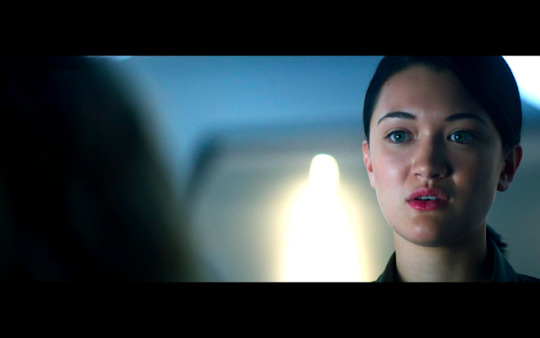
Soji’s green eyes and red lips are an unusual example of red and green playing off of each other. Seen here during her conversation in sick bay with Agnes, the color of her mouth reminds us that she’s made of flesh and blood, like a regular human being. But her green eyes are a signal that she’s something more complex than simply human.
Her eyes aren’t blue or brown, which might be neutral or just signal intelligence. They aren’t yellow like Data’s and the synths’ Agnes and Bruce made to work on Mars. Yellow would signal that Soji is an artificial life form.
According to the code of Star Trek: Picard, green eyes mean that Soji is someone to keep an eye on. She can take care of herself and she will. She’s proven herself equal to the Romulan spies and the Federation do gooders. Next up- the Vulcan strategist.
Blue Is Reason and Clarity
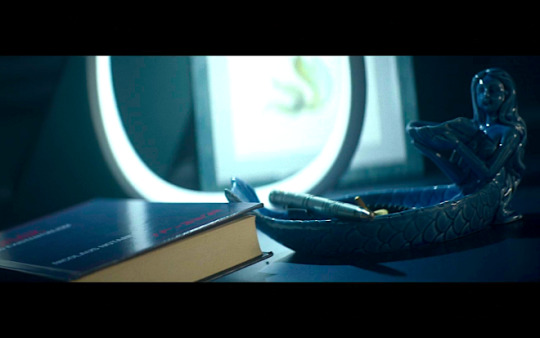
If red is associated with humans and green with Romulans, blue is the color for Vulcans. Even though Commodore Oh seems a strange choice to associate with reason and clarity, she is a half-Romulan Vulcan who believes she is following an essential course of action. She has followed a secret, calculated path for decades in order to impose the will of the Zhat Vash on the Federation. Just as importantly, the legendary father of Vulcan civilization, Surak, is associated with the color blue, thanks to Rios’ book, titled Surak and Existentialism.
As with science and philosophy, blue is morally neutral. Agnes, a scientist and reluctant spy, is strongly associated with the color. She wears two different blue coats and Oh gives her a blue tracker to chew and swallow. She sits under blue skies at the Daystrom Institute, picnicking. Like her colleague Bruce Maddox, she seems to care much more about the science than about who’s paying for it. I believe her allegiance is currently to herself and to Soji, because Soji is the culmination of her life’s work, even if Bruce finished the project alone.
Click on any photo to enlarge.
Each color not only appears at times with the other colors, at times its meaning intensifies until it becomes its opposite. Thus, blue is the color of science, logic and philosophy, but also religion, mythology and belief. It’s associated with both the Borg Collective and the Free xBs.
Say what you will about them, the Borg have clarity of purpose and the xBs are newly free, in search of their own identities. They are at risk for joining cults or forming one themselves, as has been seen previously in ST:TNG. But they are also seekers who will sift through multiple philosophies and religions to create an inner monologue that fits their own experience. Isn’t this what Surak did for the Vulcans when they were at risk of destroying themselves through violence and chaotic thought?
Raffi’s colors, when she has her addiction under control, are the same as Jean Luc’s: blue and red. She wears a purple sweater in episode 5, the combination of the two colors. She uses logic and reason intensely in her analysis of everything she comes into contact with.
There were purple flowers at Chateau Picard. Picard is a philosopher and a humanist.
In episode 7, Deanna Troi wore blue in the latter half of the episode, suggesting she felt more professional and neutral as the Admiral’s visit continued.
Narek is also occasionally associated with blue, since like Agnes, he is both a scientist and a spy.
Gold Means Safety and Security But It Can Also Be an Illusion
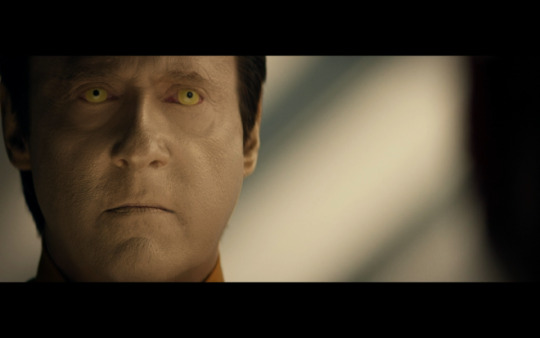
There haven’t been many uses of colors in the gold/yellow family so far, perhaps to give the color an impact when it is seen. Mainly Data and the Mars synths’ skin. Plus the golden light at Chateau Picard, a fake version of which now shines in Picard’s holostudy on the La Sirena.
Gold is also the accent color for the security and engineering departments in Starfleet, as we’ve seen it on Oh and Narissa’s uniforms.
The meaning of gold is derived from the Starfleet uniforms: security and safety. But it can also mean the opposite, as it would when the starship’s engine fails or it’s invaded by hostile forces. Then the sense of security that the crew feels turns out to be an illusion. Illusions and other mistakes made by the mind are running themes throughout the season.
There were touches of yellow in Data’s poker hand of 5 identical queens of hearts in Picard’s episode 1 prophetic dream. The sands of Aia, the grief world, where the Admonition takes place are a soft gold. After enduring both the Admonition and assimilation, Ramdha spends her time seeking to see the future with tawny golden pixmit cards that may or may not give her accurate predictions.
That would bring us back around to the artificial golden light of the holostudy vs the real sunlight at the actual vineyard on Earth. The two rooms are twins to the naked eye of TV viewers, but in reality they are far different.
Someone who is physically in each room could tell the difference, because they could smell the air of the vineyard, feel the breeze and the warmth of the sun, hear the small noises that it would be difficult for a holosuite to replicate perfectly. On the ship, you’d feel the small sensations that signify motion.
In the same way, this season has used twinning and mirroring over and over.
There are many Rios and Sojis. Despite the tragedy which brought them together, the two characters have a strong connection. There are still many questions about what really happened on the Ibn Majid and about the rest of Rios’ background. It was a surprise to hear he has no family. He and Soji are both searching for identities and families. It’s suspicious that the drawing is of those two, as if they were the pair of synths. I can’t see how that’s possible, but maybe Rios DNA was used?
Narissa and Narek are siblings with opposite approaches to life. Narek told Soji he’d lost a brother in the recent past, but Narissa has never mentioned him. Narissa is devoted to Ramdha, but Narek keeps his distance and doesn’t admit she’s family.
Ramdha named Soji as an important twin, The Destroyer, but Ramdha’s mind is confused and Narek says it always has been. We saw her turn to madness. Narek may have lied to Soji on the surface, but he also told her more truths than I think even he realized. But he is also clearly devoted to Narissa and their cause. Ramdha, Soji, Narissa and Narek form an impossible box rather than a traditional love triangle. A box should be secure, but this one is full of treachery.
The synths on Mars, such as F8, mirrored Data externally but were much more simplistic internally. That external twinning allowed the conspirators to convince the Federation that they were capable of a rebellion. The A500 model synths were very purposely made as fool’s gold rather than real gold, but Starfleet and the Federation succumbed to the lie that they could evolve and rebel.
Very few people in the Federation would have known Data personally, but many would have known of him and seen his likeness. If Commodore Oh and other Vulcans in Starfleet forced the Admonition on others and are able to alter memories, then either plant hypnotic suggestions or blackmail others into doing what they want, as they did with Agnes, then they could quietly take over Starfleet and eventually the Federation. We saw Oh and Narissa wearing that gold uniform. How many more are there? How many can force the Admonition onto unsuspecting, unprepared citizens?
Star Trek Picard S1E1 Data Shows Picard His Hand- 5 Queens of Heart
Rios’ Red Is Real cigar box with all of his important memories inside.
Orange and White, the colors just to the other side of yellow, follow from its meanings. Orange, like the jumpsuits worn by the synths on Mars, means danger. White pulls yellow to the security side of the spectrum and tends to mean innocence or the medical field, when it has a meaning. In a show full of neutral colors, sometimes white is just a background color. Rios’ drawing of himself with Jana was on a white piece of paper.
What Do We Do With All of These Colors? Red Still Means Command, So We Follow (Picard) Red
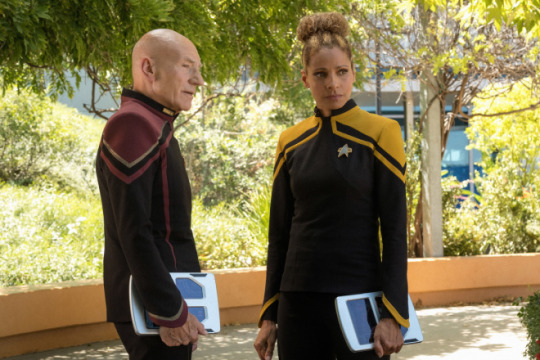
We’ve been told that red is real, but real isn’t always better. Gold is good, but it can turn on you. Green’s games can be fun, until they betray you. Blue is smart, but it tends to hang back, saying it doesn’t want to get involved, until the fight comes directly to it.
So who is a TV viewer to trust for clues to this mystery? My money is on Jean Luc Picard’s instincts overall. As a leader, he still knows what he’s doing. He’s assembled a crack team, almost despite himself and them.
However, he is truly aging and ill. Now he’s best as an administrator, rather than a man of action. The Charlie to his Angels. He needs to set his team up with a mission, inspire them, keep them on the right course when necessary, but otherwise stay out of their way.
There’s nothing wrong with that. That’s the real part of reality. They all respect what he has to offer and where he is physically. Every elderly and disabled person should be so lucky.
With Picard’s wisdom and impeccable instincts to guide them, Rios’ heart/compassion and leadership skills, Raffi’s sheer intelligence and analytical skills, and Agnes’ science and robotics skills, they have a good team. I suspect Soji is the best fighter on the ship and will be great at leading away teams, plus she’s still Dr Soji Asha, xenoanthropologist.
Picard- red
Agnes- blue
Soji- gold
Raffi- green
Rios- Between the holos and the items in his room, Rios is both red and all of the colors and skills. He’s an international man of mystery and captain of the ship. Just don’t ask him for Yridian tea.
I expect more crew will be along any time now, but maybe Seven and Elnor will keep the cube.
Images courtesy of CBS AllAccess.
Star Trek: Picard- Color Theory Explained Through E8-Starting with Bing Crosby singing Blue Skies during Picard's prophetic dream in the pilot, the show has used red, blue, green and gold symbolically. Red is real. #StarTrekPicard From the first moments of Jean Luc Picard's dream in the pilot, Star Trek: Picard has been using a color scheme as part of its symbolism.
#breakdown#color theory#commentary#meta#metacrone#review#science fiction#Star Trek#Star Trek: Picard#Star Trek: Picard- Color Theory Explained Through Episode 8
0 notes